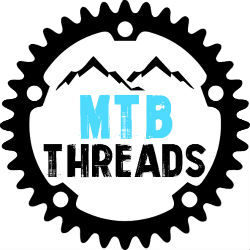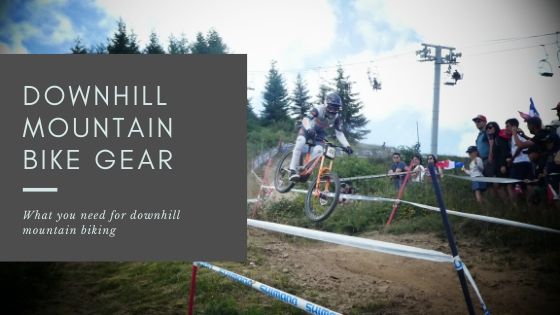Downhill Mountain Bike Gear
Downhill Mountain Bike Gear
Are you thinking of getting into downhill mountain biking? Well, you have come to the right place. In this post I am going to go through all the downhill mountain bike gear you will need. A word of warning though, as this will create an expensive shopping list, but I will help you choose the best stuff for you along the way.
The Bike

As the name suggests, a downhill bike is made for going downhill as fast as possible over rough terrain. They are big, tough and heavy in order to cope with the punishment modern downhill trails dish out. Their gearing is pretty terrible for climbing, but great for accelerating while descending.
You can learn more about them in my post what is a downhill mountain bike? but their biggest defining feature is their suspension. They have lots of travel, usually 200 to 210mm, so it can soak up the bumps and the impact from big jumps and drops.
Helmets

When riding any kind of bike, you need a helmet. But, a downhill bike requires a proper full-face helmet designed for the job in hand.
Downhill helmets are designed to take bigger hits and provide more coverage to keep your head as safe as possible. Some riders may be tempted to choose motocross helmets, as they look quite similar. However, these are made for much bigger impacts and are not suitable for mountain biking. This is because, helmets protect your head when they distort under the impact, dispersing the shock. A motocross helmet probably won’t distort enough in a mountain bike crash, therefore, you get the full force of the impact on your head. Check out some great full-face helmets reviews here.
Other Protection

You are going to need some other protective downhill mountain bike gear. How far you go will all depend on how much protection you want.
Body Armour
Many downhill mountain bikers opt to wear body armour. This is because downhill riding involves high speeds and technical terrain. There is no such thing as a comfy rock, and when you land on one, you will be thankful for some protection.
There are lots of different levels of body armour from lightweight breathable items that fit easily under your jersey, to full-on hard shell armour. Check out my guide to mountain bike body armour for all the details and some recommendations.
Elbow Pads
Elbow pads are a good idea, but you need to get some that fit properly. If you buy ill-fitting elbow pads, they will be flapping around your wrists from the first bump you ride over. The thing about elbow pads is that they are great if the bit that hits the ground is covered by them. Personally, I have been thankful for them on several occasions, but a lot of the time they move or your shoulder hits the ground first.
Some riders feel quite vulnerable without elbow pads, therefore they are pretty good for building your confidence when you are riding unfamiliar terrain.
You can learn about buying the right ones for you, with some recommendations in my guide on mountain bike elbow pads.
Knee Pads
I always ride with knee pads, but which ones you decide to buy is down to personal preference. You can get all sorts of knee pads from lightweight ones that are ideal for cross country and trail riding. However, for downhill mountain biking, I recommend that you go for something more robust. I wear full shin and knee guards, although they took a bit of getting used to, they have saved me on several occasions. When I have been sliding down a gravel trail on my knees, they have quickly become my favourite items of mountain bike gear. Check out my guide to choosing the best mountain bike knee pads.
Neck Braces
A few years ago, neck braces were quite popular with downhill mountain bikers, thanks to pro riders wearing them on the World Cup circuit. You don’t see them very often on recreational riders these days, as they do have their limitations, such as their restricted range of movement. So, should you wear a neck brace?
If you are just riding trails, even with some technical terrain and jumps, it probably isn’t worth it (unless you have some kind of medical condition). But, if you are racing downhill, free riding or taking on massive jumps, you may want to consider it. You can learn more about mountain bike neck braces in my guide.
Mountain Bike Goggles
When you are riding downhill trails, you get a lot of dust, mud and rocks kicked up. Therefore you need to protect your eyes. Some people prefer to wear glasses, but I recommend a good pair of mountain bike goggles for downhilling. This is because they offer more protection and are a better fit with your full-face helmet. Check out my guide to the best mountain bike goggles for all the information.
Clothing

Downhill mountain bike clothing is a little different from what other riders wear. The main characteristic of downhill clothing is that they tend to be baggier, especially jerseys. The idea behind this is so you can fit body armour under it. Check out all my posts about mountain bike shorts, for all the information.
The shorts downhill mountain bikers wear are also slightly baggier, but the main thing you will notice is that they are made from tougher materials to make them more durable, especially for when you crash. Check out all my posts about mountain bike jerseys to learn about the best ones for you.
Footwear

You have two choices when it comes to mountain bike shoes, flats and clipless. Flat pedal shoes are exactly how they sound, but they have super grippy soles and shock-absorbing properties to keep your feet comfortable. Clipless shoes attach to the pedals. This gives you more security and more efficient pedalling. Which type you choose is down to personal preference, but you may want to go with flat pedal shoes in the early days. Check out all my posts about mountain bike shoes to help you decide.
Now you have a basic list of downhill mountain bike gear. I recommend that you gradually accumulate it over time, as I’m sure you are aware, this is all pretty expensive stuff. But, I recommend that a decent helmet should be at the top of your kit list. Don’t try to save money on protecting your head, you only get one.
If you have any questions about this, please leave them in the comments section below.




